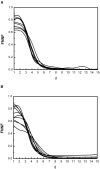Revealing alterations in heart rate fluctuations during the progression of Chagas disease
- PMID: 39318596
- PMCID: PMC11419973
- DOI: 10.3389/fmed.2024.1438077
Revealing alterations in heart rate fluctuations during the progression of Chagas disease
Abstract
Introduction: The heart rate variability (HRV) continually evolves throughout life, reflecting modifications in the architecture of the sinoatrial node (SAN) and in the regulation of heart rate by the autonomic nervous system (ANS). Both can be considerably affected by Chagas disease, causing important changes in the complex nature of HRV. We aim to evaluate the ability of an index based on the false nearest neighbors method (FN10) to reflect these changes during disease progression.
Methods: We perform a retrospective, descriptive, and cross-sectional study analyzing HRV time series of participants with Chagas disease. We determine the dependence of FN10 on age and sex in a healthy population, and then evaluate FN10 in individuals with Chagas disease.
Results and discussion: In the healthy population, FN10 has a scaling behavior with age, which is independent of sex. In Chagas disease, some individuals show FN10 values significantly above those seen in the healthy population. We relate the findings to the pathophysiological mechanisms that determine the progression of the disease. The results indicate that FN10 may be a candidate prognostic biomarker for heart disease.
Keywords: Chagas disease; autonomic nervous system; fibrosis; heart rate variability; sinoatrial node.
Copyright © 2024 Defeo, Delaplace, Goin, Tersigni, Garavaglia and Irurzun.
Conflict of interest statement
The authors declare that the research was conducted in the absence of any commercial or financial relationships that could be construed as a potential conflict of interest.
Figures




Similar articles
-
Altered heart rate variability in angiotensin II-mediated hypertension is associated with impaired autonomic nervous system signaling and intrinsic sinoatrial node dysfunction.Heart Rhythm. 2020 Aug;17(8):1360-1370. doi: 10.1016/j.hrthm.2020.03.014. Epub 2020 Mar 27. Heart Rhythm. 2020. PMID: 32224266
-
Impacts of frailty on heart rate variability in aging mice: Roles of the autonomic nervous system and sinoatrial node.Heart Rhythm. 2021 Nov;18(11):1999-2008. doi: 10.1016/j.hrthm.2021.07.069. Epub 2021 Aug 8. Heart Rhythm. 2021. PMID: 34371195
-
The Role of the Autonomic Nervous System on Cardiac Rhythm during the Evolution of Diabetes Mellitus Using Heart Rate Variability as a Biomarker.J Diabetes Res. 2019 May 9;2019:5157024. doi: 10.1155/2019/5157024. eCollection 2019. J Diabetes Res. 2019. PMID: 31211146 Free PMC article.
-
Analysis of Heart Rate Variability and Implication of Different Factors on Heart Rate Variability.Curr Cardiol Rev. 2021;17(5):e160721189770. doi: 10.2174/1573403X16999201231203854. Curr Cardiol Rev. 2021. PMID: 33390146 Free PMC article. Review.
-
Heart Rate Variability as a Translational Dynamic Biomarker of Altered Autonomic Function in Health and Psychiatric Disease.Biomedicines. 2023 May 30;11(6):1591. doi: 10.3390/biomedicines11061591. Biomedicines. 2023. PMID: 37371686 Free PMC article. Review.
References
-
- Pan American Health Organization Factsheet: Chagas Disease in the Americas for Public Health Workers-PAHO/WHO . (2022). Available at: https://www.paho.org/en/documents/factsheet-chagas-disease-americas-publ... (accessed August 03, 2024).
-
- Pereira Nunes MC, Beaton A, Acquatella H, Bern C, Bolger AF, Echeverría LE, et al. . Chagas Cardiomyopathy: an update of current clinical knowledge and management a scientific statement from the American Heart Association. Circulation. (2018) 138:e169–209. 10.1161/CIR.0000000000000599 - DOI - PubMed
-
- Heart Heart rate variability: standards of measurement physiological interpretation and clinical use . Task Force of the European Society of Cardiology and the North American Society of Pacing and Electrophysiology. Circulation. (1996) 93:1043–65. - PubMed
LinkOut - more resources
Full Text Sources

